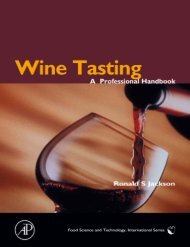Wine Production : Vine to Bottle - Vinum Vine
Wine Production : Vine to Bottle - Vinum Vine
Wine Production : Vine to Bottle - Vinum Vine
You also want an ePaper? Increase the reach of your titles
YUMPU automatically turns print PDFs into web optimized ePapers that Google loves.
88<br />
WINE PRODUCTION<br />
13.1.1 Size of the barrel<br />
The smaller the barrel the greater the surface <strong>to</strong> volume (wine) ratio<br />
and thus the greater the influence of the oak. A 225 litre barrique<br />
will give 15% more oak products <strong>to</strong> a wine than a 300 litre barrel.<br />
13.1.2 Type and origin of oak (or any other wood)<br />
American oak is coarser grained than French oak, and the wood is<br />
usually sawn, whilst French oak barrels are made from wood that<br />
is split along the natural grain of the wood. Within France, there is<br />
a distinctive difference in the oak from the various forests: Allier,<br />
Bertagne, Limousin, Nevers, Tronçais, Vosges, etc.<br />
13.1.3 Manufacturing techniques, including<br />
<strong>to</strong>asting<br />
The techniques used in the coopering of barrels vary from country <strong>to</strong><br />
country. Barrels made of American oak but coopered in France are<br />
very different from, and often preferred <strong>to</strong>, those coopered in the<br />
USA. In the latter stages of manufacture, barrels will be ‘<strong>to</strong>asted’<br />
<strong>to</strong> a greater or lesser degree, i.e. the insides, or maybe just the<br />
‘heads’ (ends), will be charred over a small wooden fire. The type of<br />
wood used <strong>to</strong> fuel the fire will have an impact upon the <strong>to</strong>asting, and<br />
consequently the wine s<strong>to</strong>red in the barrel.<br />
13.1.4 Amount of time spent in barrel<br />
His<strong>to</strong>rically wines were often kept in barrel until they were required<br />
for shipping – in some instances this might be as long as 10 years.<br />
Nowadays it is exceptional for any wine <strong>to</strong> be kept for more than<br />
three years in wood. The longer the period, the more oak products<br />
will be absorbed, the more oxygenation, possibly resulting in oxidation.<br />
The barrels will need <strong>to</strong>pping-up shortly after filling and in the early<br />
stages of s<strong>to</strong>rage. Initially barrels will be s<strong>to</strong>red with the bunghole<br />
on <strong>to</strong>p, with the bung loosely inserted or with a fermentation lock<br />
in place. Later the barrels may be s<strong>to</strong>red with the sealed bung hole
















